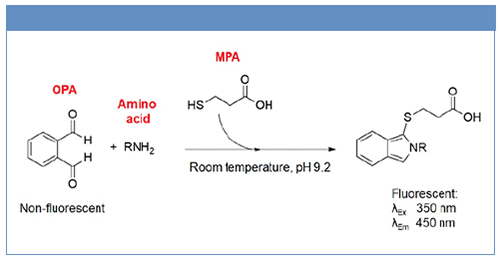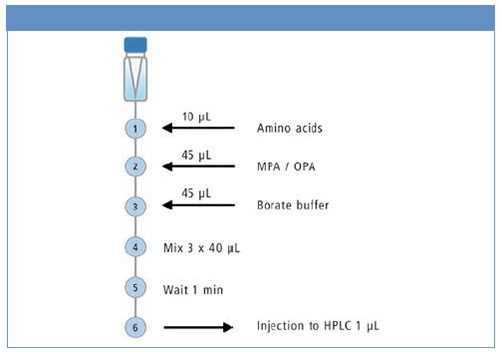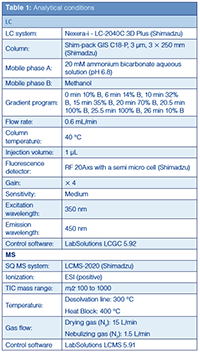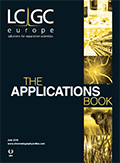Fast and Sensitive Analysis of Amino Acids Using Automated Pre-Column Derivatization
The Application Notebook
The building blocks of peptides and proteins, amino acids, are present in animals, humans, and plants. The analysis of amino acids is of essential significance in several areas including food science, clinical diagnostics, and pharmaceutical products research. Classical liquid chromatography (LC) determination of amino acids is performed with sample pretreatment including pre-column as well as post-column derivatization to improve or enable spectroscopic detection.
The building blocks of peptides and proteins, amino acids, are present in animals, humans, and plants. The analysis of amino acids is of essential significance in several areas including food science, clinical diagnostics, and pharmaceutical products research. Classical liquid chromatography (LC) determination of amino acids is performed with sample pretreatment including pre-column as well as post-column derivatization to improve or enable spectroscopic detection.
Various methods have been devised for the pre-column derivatization of amino acids. One of the most established methods is based on the reaction of o-phthaldialdehyde (OPA) with primary amines at basic conditions as shown in Figure 1 (1). The addition of mercaptopropionic acid (MPA) to the reaction solution increases the polarity of the derivatized products, reducing retention of the analytes on a reversed phase column and resulting in improved separation.
Figure 1: Derivatization mechanism of amino acids with OPA and MPA.

This work shows the application of a fully automated, rapid, and accurate amino acids pre-column derivatization method using the autosampler pretreatment function of the high performance liquid chromatography (HPLC) system. After derivatization, amino acids were separated on a C18 column and determined by fluorescence detection. The subsequent hyphenation to mass spectrometry (MS) was performed for peak tracking in real samples.
Materials and Methods
Chemicals: Ultrapure water (ASTM type 1) was prepared with a water purification system by Sartorius. Methanol and acetonitrile were of LC–MS quality (Honeywell). 3-mercaptopropionic acid (≥ 99%), boric acid (≥ 99.5%), and hydrochloric acid (≥ 37%, puriss. p.a.) were purchased from Sigma Aldrich. Formic acid (reagent grade, ≥ 95%), sodium hydroxide solution (10 M, Ultra), ammonium bicarbonate (≥ 99.5%), and o-phthaldialdehyde (≥ 98.5) were sourced from Fluka. L-amino acids standard solution (2.5 mM in 0.1 M HCl), γ-aminobutyric acid (≥ 95%), and L-glutamine (≥ 95%) were from Sigma Aldrich. DL-asparagine and DL-tryptophan (≥ 99%, respectively) were from Sigma Chemical Company.
Preparation of Mobile Phase, Derivatization Reagents, Standards, and Samples: Mobile phase A was prepared by dissolution of ammonium bicarbonate in water (20 mM) and adjusted with formic acid to pH 6.9. A 0.2 M borate buffer was prepared by dissolution of boric acid in water and adjusted to pH 9.2 with 10 M NaOH. MPA (20 µL) and OPA (20 mg) were dissolved in 10 mL of the prepared borate buffer, respectively. All derivatization regents were stored at 5 °C for a maximum of 1 week prior to analysis. A 100 µM amino acid standard was obtained by dilution of a commercially available mixture of amino acids or 2.5 mM stock solutions, which were prepared from γ-aminobutyric acid, glutamine, asparagine, and tryptophan in 0.1 M hydrochloric acid. A white wine sample was injected into the HPLC system after filtration with a 0.2-µm pore size filter.
Derivatization Procedure: The derivatization procedure is presented in Figure 2. A 10-µL amino acid standard solution or sample was transmitted to a 1.5 mL vial with a 200 µL glass inlet. A 45-µL mixture of MPA and OPA solution (1/1) was added, followed by addition of 45 µL of 0.2 M borate buffer. After mixing (3 × 40 µL) and a waiting time of 1 min, 1 µL of the mixture was injected for HPLC analysis.
Figure 2: Automated derivatization procedure of amino acids with OPA and MPA.

LC–MS Conditions: The HPLC system was equipped with a fluorescence detector, followed by a single quadrupole mass spectrometer. Analytical conditions are presented in Table 1.

Results
A total of 19 amino acids could be determined using a newly developed, automated pretreatment program for derivatization (Figure 3). The information provided by retention times as well as mass-to-charge ration (m/z) measured was applied for the determination of amino acids in a white wine sample (Figure 3 and Table 2).
Figure 3: Chromatograms of the separation of derivatized amino acids using a fluorescence detector (pink: 100 micrometre standard, black: white wine).

Conclusion
A fully automated derivatization method for amino acid analysis using the pretreatment function of the HPLC autosampler was developed. The method was applied successfully in the determination of amino acids in a white wine sample. This time-saving approach of a fully automated derivatization method, in combination with fluorescence and MS detection, is a valuable tool for laboratories requiring high throughput analysis, while also reducing the risk of human error during sample preparation.
Reference
- Z. Dai, Z. Wu, S. Jia, and G. Wu, Journal of Chromatography B964, 116–127 (2014).

Shimadzu Europa GmbH
Albert-Hahn-Str. 6–10, D-47269 Duisburg, Germany
Tel.: +49 203 76 87 0 Fax: +49 203 76 66 25
E-mail: shimadzu@shimadzu.eu
Website: www.shimadzu.eu


.png&w=3840&q=75)

.png&w=3840&q=75)



.png&w=3840&q=75)



.png&w=3840&q=75)




